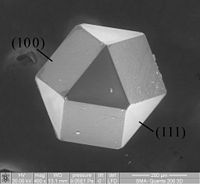
Photo from wikipedia
This work analyses the performance of parts built by Additive Manufacturing (AM) using fused filament fabrication (FFF) demonstrating the correlation between the printing orientation and structural performance. FFF components present… Click to show full abstract
This work analyses the performance of parts built by Additive Manufacturing (AM) using fused filament fabrication (FFF) demonstrating the correlation between the printing orientation and structural performance. FFF components present two regions showing different mechanical behaviour: the external contour and the inner structure (in-fills or lattice). The respective mechanical properties of the contour and the inner structure are obtained. In this work the inner structure is replaced by an anisotropic homogenized material. A Representative Volume Element with Periodic Boundary conditions is adopted to obtain the corresponding equivalent constitutive tensor. On the other hand, the contour is considered isotropic. The material characterization of both the in-fill and the contour is done following two complementary strategies: (1) an experimental campaign involving several tensile tests on FFF specimens; (2) a sensitivity analysis through numerical modelling. Performing experiments to obtain the material properties for contour and in-fill may be a challenging task. Thus, the numerical modelling and the optimization technique are used to obtain the material properties as a function of the filament properties. Calibration of the structural response of 3D-printed demonstrators under bending and torsion is done in order to optimize the material parameters of the numerical model by minimising the difference between the experimental and numerically computed structural stiffness. It is shown that assuming isotropic behaviour for the contour results in a negligible error. The AM software so calibrated can be used for analysing the mechanical performance of FFF components and selecting the optimal printing orientation as well as the contour thickness and in-fill density to satisfy the structural performance required.
Journal Title: International Journal of Mechanics and Materials in Design
Year Published: 2020
Link to full text (if available)
Share on Social Media: Sign Up to like & get
recommendations!